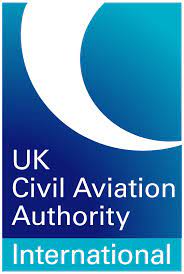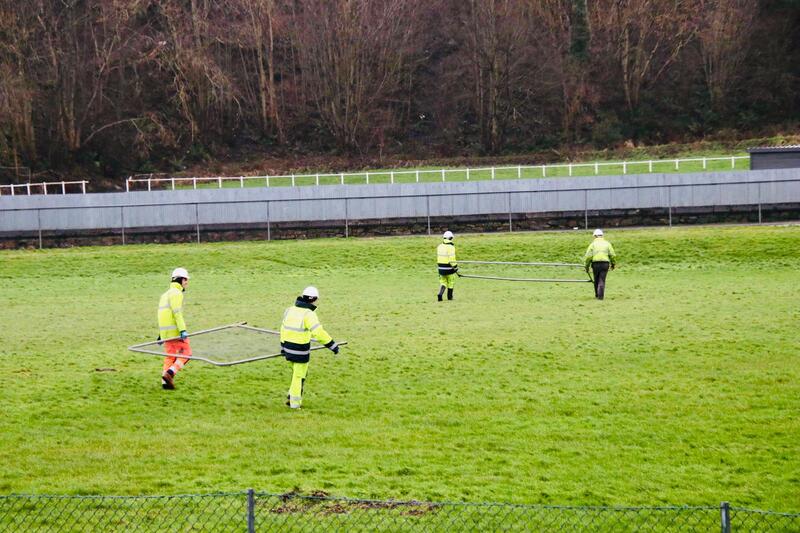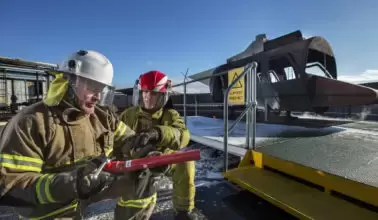|
After more than a decade of research and development, Conair’s answer to the future of aerial firefighting is the Q400AT. The purchase marks the most significant investment Conair has made to date towards developing a fleet of Next Generation aircraft designed to better fight wildfires for years to come. Planes used to fight wildfires as airtankers are often older models and are flown into demanding environments, inevitably resulting in metal fatigue over time. In addition, aircraft designed to obsolete standards leads to increased risk of incidents, costly repairs, limited replacement parts, and ultimately time grounded from fighting fires. Conair’s strategic move towards a long-term vision includes replacing the company’s fleet of heavy legacy airtankers with the new Q400ATs. “We evaluated 29 aircraft before selecting the Q400 for modification into an aerial firefighting tool. The unanimous opinion of our flight operations experts was that the Q400 exceeds all the Next Generation performance criteria within a maneuverable and stable platform,” said Jeff Berry, Director of Business Development at Conair. “The Q400AT is fast, fuel efficient, and tactically flexible, operating both initial attack, as well as sustained support actions. The Q400 is still in production and has strong Original Equipment Manufacturer (OEM) support from De Havilland Aircraft of Canada Limited (De Havilland Canada), guaranteeing availability of parts and servicing for years.” Ideal platform for special mission operations “We are delighted that Conair is acquiring another eleven Dash 8 aircraft to support the growth of the company’s specialized airtanker fleet,” added Philippe Poutissou, Vice-President of Marketing and Sales at De Havilland Canada. “In addition to being the most advanced and efficient turboprops deployed in regional airline and air transport roles around the world, De Havilland Canada’s versatile Dash 8 Series aircraft continue to be an ideal platform for special mission operations such as aerial firefighting, search and rescue and medical evacuation and we congratulate Conair on the excellent work they are doing supporting diverse communities with their Dash 8 multi-role and airtanker aircraft.” Deliveries will start this month The Q400 aircraft were purchased from HEH Hamburger EmissionsHaus, through Skyworld Aviation. The eleven aircraft, originally Flybe commuter planes, are based in Europe and will be delivered to Conair starting this month.
0 Comments
Great few days overseas, a mix of maritime and a chance to open discussions with the main hospital in Antigua, the Mount Saint Johns Hospital regarding upgrading their helipad through charity support.
British Marine is the trade association for the UK leisure, superyacht and small commercial marine industry. Our 1,500+ members come from a broad range of businesses including boat builders, chandlers, brokers, marinas, passenger boats and engines.
We are hoping to engage and provide positive support to British Marine via the various working groups and forums in influence the aviation aspects of vessel operation, predominately SAR Ops. So happy to report that after some two years in planning and delays, our Campbeltown Hospital Helipad Project is finally at the stage of construction, bringing a much needed capability to the town of Campbeltown and surrounding areas. We are planning on visiting the site in February and then for the opening in April.
The unlicensed helipad will be certified by Green Deck Operations and will operate in accordance with ICAO Annex 14 Vol II and CAP 1264. It will be capable of operating all inservice HEMS and UK SAR assets. It has been an aspiration of Green Deck Operations to deliver online dangerous Goods by Air Awareness training for some time. We are now proud to announce that in partnership with the UKs leading Superyacht Helideck Training Company, Helidecks SA, we have available to all our clients the ability to deliver online DG by Air training which meets the exacting criteria of the IATA DG Regulations.
It is a requirement in accordance with IATA and ICAO Regulations / Guidance that comprehensive and approved training must be delivered to all helideck team members to ensure they are aware of hazards posed by the transport of dangerous goods by air. It is also a requirement that re-validation training be carried out every 24 months. All crew carrying out a OPITO Helideck Team Training or an MCA Commercial Helideck Training course must have a valid Dangerous Goods by Air Awareness Training Certificate. To make is easy for crews to achieve dangerous goods certification, Green Deck Operations and Helidecks SA have developed joint online training course which has been designed to meet the dangerous goods prerequisites for the OPITO Helideck Operations Initial Training Course and the MCA Large Yacht Training Syllabus for Commercial Yacht Helidecks. The course provides an easy to understand way to ensure you are fully aware of the possible hazards associated with the transport of dangerous goods by air during offshore and yacht helicopter operations. Please go to www.aviationdangerousgoods.com for further details. The European standard for firefighter protective clothing – BS EN469 – has been revised and published in 2020. The new standard makes several key changes and improvements on the 2005 version, which we thought it would be helpful to explain for you here. Key changes in BS EN469 2020 The updated standard increases the requirement for flame spread and heat resistance testing of: • Any reinforcement material • Anti-wicking barrier – which also has size limitations added • Drain mesh – which also has size limitations • Hardware – must be tested for heat resistance only • Any label (> 10cm2), badges and retro reflective materials must be tested for flame spread as part of the whole garment. It also sets a design requirement and specifies performance testing for external pockets and gives detailed instructions about how to test hardware. The heat resistance of sewing threads must now be tested to 260°C. But the biggest change in the new standard relates to testing the ability of a garment to perform in its “as received” state. The previous standard – BS EN 469:2005 – only required garments to meet the standard after having been laundered five times. The new standard makes it clear that garments need to provide relevant protection against heat transfer and radiant heat from day one of use. Why testing “as received” is important It’s critical that firefighters have confidence in their kit and it’s ability to protect them from the extreme conditions they can face. In theory, the fibres of fabric fluff up and fabrics open up during laundering, increasing the heat protection a garment can provide. As the previous standard stated garments had to meet the requirements after being laundered five times, it is technically possible that a brand new garment didn’t meet the standard. The impact of this change to testing might be that garments need more insulation to ensure they pass the test parameters in new condition. This could make garments heavier, so needs careful consideration when specifying new kit. Aiming for a lower HTI (Heat Transfer Index) value will deliver the same heat protection to your crews. A value of 18 should be the new expectation, where 20 might have been the previous spec. There will be a weight difference between garments delivering 18 and 20 when tested as new. Changes to chemical repellancy testing added to BS EN 469:2020Firefighters’ protective clothing needs to provide a level of protection against chemicals by repelling them to stop them soaking into the garments and potentially getting on to firefighters’ skin. Key additions to annexes in BS EN 469 There have also been a number of changes to the annexes in BS EN 469:2020: • Annex A: Assessment, evaluation, and determination of the property values for rating and performance classification • Annex B: Contamination during use: guidance on cleaning and risk prevention • Annex C: Summary of the clothing heat and flame protection; selection, use, care and maintenance guidance • Annex D: Updated information on the optional whole garment test for level 2 garments using EN ISO 13506-1:2017 (currently under revision) • Annex E: Information on the new test method available for assessing the physical impact of the suit using a sweating torso The timeline for changing to all firefighter garments complying with BS EN469:2020As when all standards change, the new standard is not retrospective, so it is not the case that PPE has to immediately meet the new standard.
Just ensure that when you decide to change out your fire fighter PPE, ensure it meets the correct standard, ie the 2020 standard, that way you will be future proof! |
|








